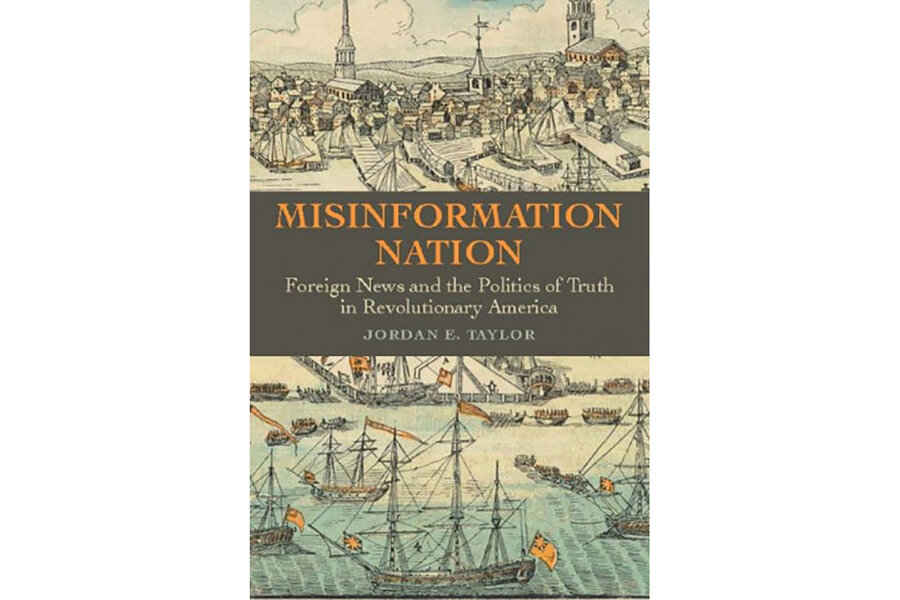Misinformation isn’t new. Colonial America was rife with it.
Loading...
In the 18th century, North Americans were desperate for news, and the continent’s first newspapers endeavored to satisfy their readers – regardless of whether their stories were accurate. In the enlightening “Misinformation Nation: Foreign News and the Politics of Truth in Revolutionary America,” historian Jordan E. Taylor quotes the printer of the South Carolina Gazette as observing placidly in 1737 that his readers, so eager for information, were “as much pleased with false News as true.” Toward the end of the century, the editor of the Massachusetts Western Star was asked by an impatient reader, “if you have no news from abroad why don’t you fabricate some?”
Taylor’s erudite and engaging debut vividly demonstrates the challenges of transmitting information in the early modern age. In the 17th century, British commercial vessels were the colonists’ primary source for foreign news. When a ship arrived at port, its captain would distribute letters he’d been asked to deliver upon reaching his destination; in addition, the crew and passengers would provide oral accounts of noteworthy events back in Europe.
Both of these information sources had obvious shortcomings: letters took months to arrive and were frequently lost at sea, while oral reports might be little more than unsubstantiated rumors. The rise of newspapers, whose numbers expanded throughout the 18th century, made the distribution of news more centralized and hierarchical. As a result, elites began to exert more influence over the information that was transmitted. “Compared to the letter-writing and oral cultures that preceded them,” Taylor writes, “newspapers were more likely to obey the whims of the mighty.”
Throughout the book, Taylor describes attempts by the powerful to control the dissemination of information. For instance, the author notes that white Southerners sought to restrict enslaved people’s access to news of revolutions in Europe and the Caribbean, concerned that it would inspire them to revolt.
Even as newspapers proliferated, misinformation continued to flourish. Taylor observes that journalism as we know it did not yet exist, and newspapers often merely reprinted letters or newspaper stories that printers received from foreign sources. With the Colonies bristling against British rule, their news became increasingly politicized. Because of the difficulty in verifying information, different newspapers frequently presented conflicting versions of the same event. Both Patriots and Loyalists “sought out and amplified congenial news sources while limiting their readers’ engagement with unfriendly newspapers,” Taylor writes. (The author’s suggestion that the misrepresentations amplified by Patriot news sources were a necessary precondition for the Revolution is intriguing if not wholly convincing.)
After the Revolution, the pattern continued in the new nation, with rival Federalists and Democratic-Republicans preferring news that reinforced their different worldviews. Americans were especially anxious for foreign news during the French Revolution. The pro-revolutionary Democratic-Republicans favored French news sources, despite the added burden of procuring translations, while the Federalists favored British. Taylor quotes from several reports on the 1793 execution of Marie Antoinette to dramatize the clashing perspectives; the British papers were aghast at the violence of the event, while the French focused on the charges against the queen. Frustrated by the inconsistent war coverage, one Boston printer lamented, “the situation of France, in one set of Prints, is represented as deplorable and ruinous – in another set, as prosperous and auspicious.”
With early America's news sources so biased, Taylor writes that “individuals’ choices as news consumers contributed to the formation of their political identities.” That sentence could easily characterize today’s partisan media landscape, as the author is well aware. He intends for his audience to reflect upon our own anxieties over “fake news” as we read about similar concerns dating back more than 200 years. In Taylor’s telling, our democracy has not only survived misinformation but was practically built on it. It's a notion that would be comforting if it weren’t so troubling.






